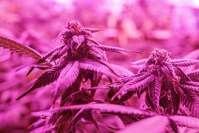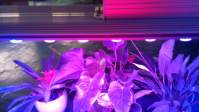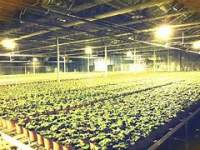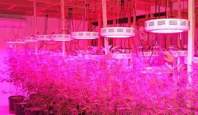Vertical agriculture is a revolutionary and sustainable agricultural method that does not require so much space and water demand, and has no impact on the ecological environment. However, the demand for light has never changed, so LED plant lights are needed to supplement light. The emergence of LED plant lights brings unlimited possibilities for the development of vertical agriculture.
Why is there vertical agriculture?
In a linear system, feeding the urban population is particularly challenging. Agriculture is limited by the amount of space for growing crops. This may limit the total output of the farm, making it difficult to expand and produce more food. This is also the reason for the emergence of vertical agriculture. Vertical agriculture is carried out indoors, eliminating the possibility of environmental damage such as weather, pests and diseases. This agricultural method ensures that all plants receive the same amount of light, water and nutrients.
"LED plant lights in agriculture will be ubiquitous, and all fields of modern agriculture are closely related to light," said Yang Qichang, a senior expert in the field of agriculture and a researcher at the Institute of Agricultural Environment and Sustainable Development of the Chinese Academy of Agricultural Sciences. The planting industry of modern agriculture ( For example, facility gardening, urban agriculture, open field production, plant protection and trapping, etc.), livestock and poultry breeding, aquaculture, and other (edible fungi, microalgae, etc.) all require artificial light sources to supplement light, so the role of LED plant lights will increase. Bigger.
The LED plant light can be designed to emit a specific wavelength of vertical agricultural planting light source, which can be used as an alternative light source for sunlight. Plants do not use the entire spectrum. Plants mainly absorb only part of the spectrum. The peak wavelength of chlorophyll absorption is about 450 nanometers and 650 nanometers (blue and red, respectively). Vertical agricultural growth lights using LED plant lights can be designed to emit only these wavelengths, thus providing only the light needed by plants.
We can know from the above that the growth of plants has nothing to do with soil. What plants need is light. The development of vertical agriculture is to break through the limitation of land space. As long as the light demand is met, plants can grow.
The following are several innovative cultivation methods for vertical agriculture:
1. Hydroponics
Hydroponics is a new method of plant cultivation, and it is also the most widely used method in vertical agriculture. This method does not require soil, but uses nutrient solution to cultivate, which is more convenient to cultivate and the plants are safer.
2. Aerosol cultivation
Aerosol cultivation technology is a new type of cultivation method. Aerosol cultivation is similar to hydroponics. The difference is that the nutrient solution is atomized and sprayed directly onto the roots of plants in the form of spray to provide the water and nutrients needed for plant growth. , And there is the ability to reduce water consumption.
3. Fish and vegetable symbiosis
The fish and vegetable symbiosis system is very similar to the hydroponic system, but one more is to integrate fish and plants together and use each other. The water purified by the plants is used for the fish ponds, and the waste generated by the fish can serve as the nutritional needs of the plants. .
4. Lokal-a self-sufficient small household vegetable system
Lokal technology is the combination of hydroponics and LED plant lights. Nutrient solution replaces soil and LED plant lights replace sunlight, so that plants can also be grown indoors without being restricted by environmental or geographical conditions.
5. AeroFarms-Intelligent Vertical Agriculture Innovation
AeroFarms technology combines the latest technologies such as LED plant light supplement light, aerosol cultivation technology and climate control to control and regulate various factors in line with the growth of plants, giving plants the best growth environment, but the investment cost may be higher. But now there are many successful cases abroad.
Features of LED plant lights:
1. Increase yield: The energy needed for plant growth comes from the photosynthesis of plants, and photosynthesis requires sunlight, and LED plant lights can supplement light to plants when the light is insufficient, and promote the accumulation of plant dry matter, thus achieving the purpose of increasing yield. .
2. Early market: LED plant lights can shorten the growth cycle of plants, promote the growth of plants, can make crops go on the market 7-15 days in advance, greatly increasing the economic income of users.
3. High luminous efficiency: 90% of the light emitted by LED plant lights can be absorbed by plants. Traditional plant lights such as high-pressure sodium lamps and metal halide lamps can only absorb 8-10% of the light during photosynthesis.
4. Low power consumption: LED plant lights consume very little power, so users do not have to worry about the cost of supplementary lights.
5. Long lifespan: LED plant lights have an extremely long lifespan, with an ultra-long lifespan of 50,000 hours to ensure long-term safe and efficient operation of the product.
6. Environmental protection: LED plant lights are safe, environmentally friendly and do not contain toxic mercury. Our LED grow lights use 10%-30% more energy than traditional lights. Consuming less energy can reduce greenhouse gas emissions into our environment.
Vertical agriculture is growing as an increasingly accepted mode of production. These innovative technologies will become more and more popular and will completely change the face of agriculture in the future! The development of agricultural planting is inseparable from light, and the same is true for vertical agriculture, and most of them are indoor planting, so it is natural to need supplementary light. LED plant lights are now the most popular plant supplement light for indoor planting. The development of vertical agriculture will bring a wave of new markets and opportunities to LED plant lights.






